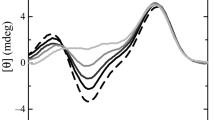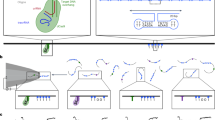Abstract.
DNA sequences with guanine repeats are able to fold as G-quadruplex (G4) structures. This is an alternative DNA conformation in which four guanines are arranged as a tetrad, the structural unit of G4; two or more stacked tetrads form a G4 structure. The hydrogen bonds characterizing G4 are called Hoogsten bonds but more interactions are involved in the G4 structure stabilization. For example, cations work as G4 stabilizers and their role is not restricted to the structural folding. They coordinate the guanines’ carbonilic oxygens located towards the hydrophobic channel of the G4 inner structure. This feature suggests that the G4 could work as a cation biosensor. Biological media are characterized by the simultaneous presence of K+ and Na+ exhibiting different affinities and thus promoting different topological arrangements in the folding solution. In this article we explore the possibility of using PS2.M, an 18 base long synthetic oligonucleotide, as a detector of K+ at concentrations in the range 0mM to 10mM. Our intent is therefore to study a biosensor that is made of the G4 sequence only, without intervention of other coupled molecules. As with most guanine-rich oligonucleotides, also PS2.M shows different structures depending on the folding conditions. In agreement with the literature data, our results outline the expected behavior and the key role of K+ and Na+ in promoting the folding, with Na+ promoting the antiparallel structure formation of PS2.M, even at high concentrations. On the other hand, if PS2.M is folded in 10mM to 100mM KCl solutions, the parallel conformation sets in becoming more and more relevant as concentration grows. In a complex solution of G4 in the presence of both K+ and Na+ ions, spectra display the coexistence of parallel, antiparallel and mixed type conformations. Results show that the CD spectra values at this wavelength can be diagrammed as a function of the K+ concentration to construct a biosensor calibration curve. In conclusion, given a Na+ concentration in the range 50mM to 80mM and K+ concentration in the range 0mM to 10mM, the measured CD signal at 263.6nm permits a K+ concentration measurement with a resolution of ∼ 1 mM.
Similar content being viewed by others
References
S. Burge, G.N. Parkinson, P. Hazel, A.K. Todd, S. Neidle, Nucleic Acids Res. 34, 5402 (2006)
S.K. Mishra, A. Tawani, A. Mishra, A. Kumar, Sci. Rep. 6, 38144 (2016)
B. Ivar, Biochem. Z. 26, 293 (1910)
M. Gellert, M.N. Lipsett, D.R. Davies, Proc. Natl. Acad. Sci. U.S.A. 48, 2013 (1962)
B. Ruttkay-Nedecky, J. Kudr, L. Nejdl, D. Maskova, R. Kizek, V. Adam, Molecules 18, 14760 (2013)
C.E. Pearson, R.R. Sinden, Curr. Opin. Struct. Biol. 8, 321 (1998)
G.N. Parkinson, M.P.H. Lee, S. Neidle, Nature 417, 876 (2002)
O. Doluca, J.M. Withers, V.V. Filichev, Chem. Rev. 113, 3044 (2013)
N. Maizels, Nat. Struct. Mol. Biol. 13, 1055 (2006)
N. Maizels, L.T. Gray, Plos Genet. 9, e1003468 (2013)
R.D. Gray, J. Li, J.B. Chaires, J. Phys. Chem. B 113, 2676 (2009)
G.N. Parkinson, R. Ghosh, S. Neidle, Biochemistry 46, 2390 (2007)
P.R. Majhi, R.H. Shafer, Biopolymers 82, 558 (2006)
D. Bhattacharyya, G. Mirihana Arachchilage, S. Basu, Front. Chem. 4, 38 (2016)
W. Liu, H. Zhu, B. Zheng, S. Cheng, Y. Fu, W. Li, T.C. Lau, H. Liang, Nucleic Acids Res. 40, 4229 (2012)
D.Z. Yang, K. Okamoto, Future Med. Chem. 2, 619 (2010)
H.Z. He, D.S.H. Chan, C.H. Leung, D.L. Ma, Nucleic Acids Res. 41, 4345 (2013)
N. Shahbazi, S. Hosseinkhani, K. Khajeh, B. Ranjbar, Biopolymers 107, e23028 (2017)
P. Travascio, Y. Li, D. Sen, Chem. Biol. 5, 505 (1998)
G. Wang, L. Chen, Y. Zhu, X. He, G. Xu, X. Zhang, Biosensors Bioelectron. 61, 410 (2014)
D.M. Kong, L.L. Cai, J.H. Guo, J. Wu, H.X. Shen, Biopolymers 91, 331 (2009)
X. Cheng, X. Liu, T. Bing, Z. Cao, D. Shangguan, Biochemistry 48, 7817 (2009)
S. Croci, L. Bruni, S. Bussolati, M. Castaldo, M. Dondi, Cancer Cell Int. 11, 30 (2011)
L. Bruni, A.A. Babarinde, I. Ortalli, S. Croci, Cancer Cell Int. 14, 77 (2014)
S. Paramasivan, I. Rujan, P.H. Bolton, Methods 43, 324 (2007)
V. Viglasky, L. Bauer, K. Tluckova, Biochemistry 49, 2110 (2010)
A. Bugaut, S. Balasubramanian, Biochemistry 47, 689 (2008)
P.C. Wei, Z.F. Wang, W.T. Lo, M.I. Su, J.Y. Shew, T.C. Chang, W.H. Lee, Nucleic Acids Res. 41, 1533 (2013)
M. Lu, Q. Guo, N. Kallenbach, Biochemistry 32, 598 (1993)
T. Li, E. Wang, S. Dong, Anal. Chem. 82, 7576 (2010)
X. Sun, Q. Li, J. Xiang, L. Wang, X. Zhang, L. Lan, S. Xu, F. Yang, Y. Tang, Analyst 142, 3352 (2017)
Author information
Authors and Affiliations
Corresponding author
Rights and permissions
About this article
Cite this article
Bruni, L., Manghi, M. & Croci, S. PS2.M: Looking for a potassium biosensor. Eur. Phys. J. Plus 133, 337 (2018). https://doi.org/10.1140/epjp/i2018-12155-2
Received:
Accepted:
Published:
DOI: https://doi.org/10.1140/epjp/i2018-12155-2




